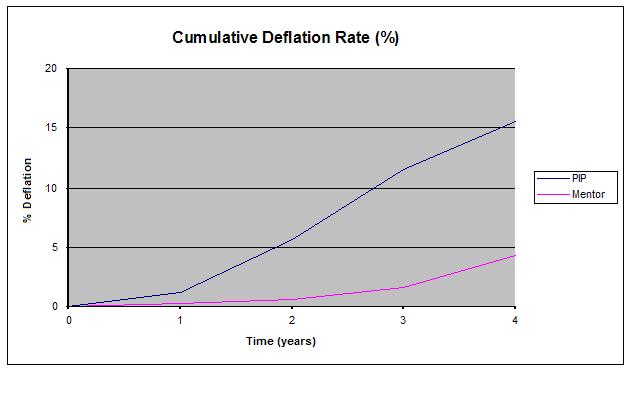Tuesday, September 27, 2005 - 11:00 AM
8019
Assessing the Deflation Rates of 500 Pre-filled Textured Saline Breast Implants Versus 500 Standard Textured Saline Breast Implants: Is There a Difference?
Purpose: To date, no large study of the deflation rates of PIP pre-filled textured saline breast implants has been published. This study provides the first large volume (1000 implant) comparison of the deflation rates of PIP pre-filled textured saline breast implants versus a control group of Mentor Siltex textured saline implants. The goal of this study is to determine whether PIP pre-filled textured implants deflate at a significantly higher rate than Mentor Siltex implants.
Methods: A consecutive series of 500 PIP pre-filled textured saline breast implants was compared to a consecutive series of 500 Mentor Siltex breast implants. Each breast implant was evaluated for a four-year period, and the annual deflation rate (number of deflations during a given year divided by the total number of implants) and cumulative deflation rate (cumulative total of deflations through a given year divided by the total number of implants) were recorded. Statistical significance was calculated with a chi square analysis.
Results:
The results of the PIP implant series are given below:
The results of the
At year 1, the difference between the cumulative deflation rates is not statistically significant at the a= 0.05 significance level (chi square 2.30, p >0.05); however, at year 2 (chi square 13.29, p<0.001), year 3 (chi square 37.91, p<0.001), and year 4 (chi square 32.69, p<0.001) higher deflation rate of the PIP implants versus the Mentor implants is statistically significant.
Discussion: Our data clearly indicates that there is a statistically significant difference between the overall deflation rates of PIP pre-filled textured saline breast implants and Mentor Siltex breast implants at year 2 (p< 0.001), year 3 (p< 0.001), and year 4 (p< 0.001). After 4 years, the 15.56% cumulative deflation rate of PIP implants was over 3.5 times higher than the 4.31% deflation rate of the Mentor Siltex implants. There may be several factors contributing to the higher deflation rate seen in PIP implants, including possible in-vitro deflation before implantation and silicone shell curing technique. Regardless, this statistically significant deflation difference must be taken into account when balancing the risks and benefits of PIP breast implants.
View Synopsis (.doc format, 98.0 kb)
See more of Breast (Cosmetic and Reconstructive)
Back to 2005am Complete Scientific Program



